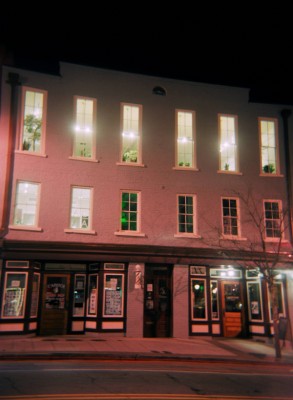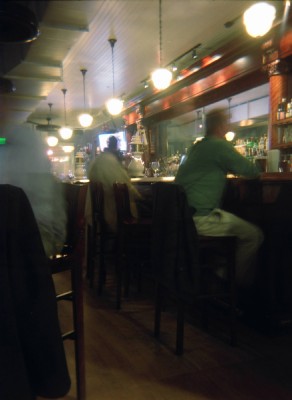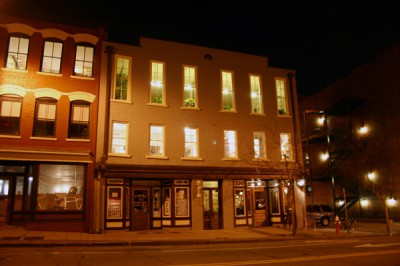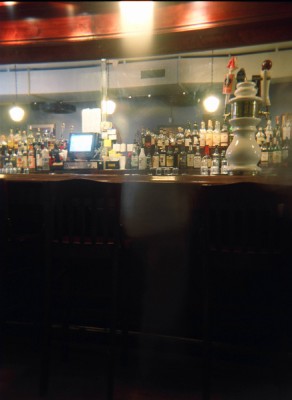Making a Landing at the Landmark Tavern

above Holga image credit: Ben Spiker
Although my ‘bar hopping’ days are long gone, I do enjoy going out on occasion for drinks with friends to any of downtown Raleigh’s ‘public houses.’ One of my favorites is the Landmark Tavern on E. Hargett Street.
This quintessential neighborhood bar has been open for little more than a year now, yet it has already achieved, well, landmark status. The low-lit interior is cozy and well appointed with wood paneling, stained glass panels, antique-style light fixtures and comfy booths. It is a very inviting space. There’s even a private outdoor beer garden.

above Holga image credit: Ben Spiker
But one of the main attractions of the Landmark is the bar itself. Owners Brendan and Linda O’Reilly brought in and restored the historic bar, originally located in an establishment in Hooversville, Pa. When the massive quarter-sawn oak bar was being reassembled, they discovered an old black and white photograph from 1911 that depicts it in its original location.
In the photo you can see patrons decked out in derby hats and coats and ties. Behind the bar the barmen pose in their long white aprons. In those days women were not allowed in drinking establishments. As public restrooms were scarce then, the face of the bar was equipped with a certain floor-level convenience intended to accommodate the all male clientele. Umm…you’ll have to ask one of the present-day bartenders to explain it to you.
Now for a little Raleigh history.
The 3-story brick building the Landmark is located in is a Hargett Street landmark itself. Long associated with Raleigh’s once thriving early 20th century African-American business district, it has had many tenants over the years. One Raleigh property map indicates that the building has occupied this spot as early as 1881. It first appears on the Sanborn Insurance maps in 1884, and by 1888 the Oak City Manufacturing Co. —a wholesale clothier employing ’60 hands’— occupied the building.
During the 1890s the street level floor was divided into separate storefronts. The Landmark space was occupied over the next few years variously by a grocery, printing establishment and even briefly as a venue for ‘moving pictures’ in 1910. As early as 1903 the upper floors housed the Grand United Order of Odd Fellows, a black fraternal organization, and within 10 years black professionals and businessmen occupied the entire building.
From 1911 through the 1930s Mallette’s drug store operated out of the Landmark Tavern space. It was supplanted by the Community Drug Store in the 1940s and 1950s. Later the space was home to the Hargett Street Billiard Parlor.
As Raleigh’s ‘black main street’ faded into history in the early 1960s, the lodge hall was abandoned and the black professionals gradually vacated the building. Although Capitol Barber Shop, once known as Capital City Barber Shop, has remained steadfast in its location at 115 E. Hargett since 1932, during the waning years of the 20th century the Landmark space at 117 was often empty.

above image credit: Raleigh Boy
In this century Empire Properties has breathed new life into the old building and nowadays an art gallery, various small businesses, the old mainstay, Capital City Barber Shop, and the new kid on the block, the Landmark Tavern, are all thriving.
No matter if you drop in at the Landmark after work on a weekday, during peak hours on weekend nights, or on a sleepy Sunday afternoon, the friendly bartenders will greet you and serve you up a remedy for whatever ails you. Oh yeah, PBR is only $2.50 for an imperial pint.
I’ll see ya at the Landmark—and be sure to ask the bartender for a look at the photograph behind the bar.

above Holga image credit: Ben Spiker
Thanks to Linda and Brendan O’Reilly, and bartenders Pete, Gary, Shelby, Sandra, Ricky and Chico for supplying me with information for this article.

 Sign up for the Newsletter
Sign up for the Newsletter
02/12/2009
Where is the picture from 1911 displayed? Is it in the bar itself? I’m there all the time and have never seen it.
02/12/2009
Oh, also… You need to add Ian to the Contributor list in the sidebar!
02/12/2009
@Abby – You’ve never seen the old photo of the bar? It’s amazing! They don’t have it hanging up. It’s behind the bar on a shelf. Just ask one of the bartenders and they’ll let you see it.
02/12/2009
I’ll have to take another look at the picture, but I swore those weren’t urinals, but spittoons.
02/12/2009
Jason!– just going on what I was told. I saw the spitoons too. Don’t think they’d function very well for the other purpose!
02/12/2009
Raleigh Boy — I am so impressed that you know the term ‘beer garden’. Every time I use that phrase in the south, people give me a blank stare. They are all the rage in Iowa and Chicago, at least… You should also check out Sitti, as they have the most unique beer garden (ok dining/beer garden) in town,nestled between the Cherokee offices, Sitti ‘proper’, the former Riveria space, and the NCSU College of Design Downtown Studio (updstairs). Another notable beer garden is to be found at Slims. If you want a quiet drink with friends at 5:00 in the afternoon, the beer garden is usually empty at that time and offers nice shade in the summer months. Three cheers for these three Raleigh beer gardens!!!
02/12/2009
Stefanie– Thanks for the rundown of notable Raleigh beer gardens. I’ll have to check ’em out! I use that term all the time to designate a relaxing spot outside to gather and enjoy beer in the company of friends.
My use of the term comes from the moniker given to my backyard about 15 years ago by a dear friend of mine. If you say ‘beer garden’ to anybody in my circle friends they will automatically say ‘Oh, Raleigh Boy’s backyard!’ Oh, and it’s really cool and shady back there in the summertime too, compliments of an 80+ year old elm tree.
02/12/2009
Yep, RB’s an expert on beer gardens. Great article, and I love the Holga shots, especially the second photo. Hope you feature more Holga photos in the future.
I’ll have to meet my PBR-loving pals at the Landmark sometime soon!
02/12/2009
Arial– haha… Thanks for your comments! And yes, we will be featuring more Holga photos in the near future! In the meantime, I’ll see ya at the Landmark!
02/12/2009
Abby – I’m a bit behind in site maintenance due to a few things that have come up this week (most prominently being the death of my camera), but I look to get Ian (and Paul) added to the sidebar pronto.
Thanks for making sure we keep on top of our game.
Ben – I _LOVE_ these photos and hope you will continue to contribute your Holga shots to the site. They have a certain amount of warmth and life that are lacking even in 35mm photographs. Really looking forward to what else you have in store for readers of the site.
RB – this is a very enlightening article. I also hadn’t heard about the 1911 photo, but now want to check it out. Landmark was mentioned on several occasions on the “Who is your favorite bartender” post, so perhaps we should get some photos of these legendary bartenders that Raleighites love so much.
02/12/2009
I remember seeing a photo in the men’s room of a Raleigh restaurant – I believe it was Chili’s on Glenwood but I haven’t been there in years – of a bar with a urinal underneath it. That’s why it was in the men’s room. It might still be there. They may have remodeled and taken it down. Or it may have been somewhere else. But I do remember that picture.
02/12/2009
Landmark is one of my favorite watering holes in town. It lacks the pretentiousness and artsy-fartsyness that has crept up and overtaken some of the other local establishments. And it’s a great place to just knock a few back with friends and strangers without being told who & what is “cool” by the owners.
02/13/2009
Magnus– you got that right bro
NCSU– Thanks for the ‘eyewitness account’ –of sorts. I just figured something that conveniently practical had to be true… I can’t make this stuff up!
02/13/2009
I’ll have to check out this bar. Sounds like my kind of place. I feel so OLD when I walk into most of these joints. I usually start with something local on tap or a nice dry Martini, but when I switch over to Miller Lite, boy do I get the looks! I’ve committed an unpardonable bar sin!
Why is it that all these cool bartenders always ask “Vodka?” when I order a Martini? If I had wanted vodka, I would have ordered a “vodka Martini.” I suppose I should be thankful they ask. My waiter at the Pit just brought me a vodka Martini, without even asking.
And why is PBR cooler than Miller Lite?
Just wonderin’ and ramblin’. It IS Friday. :)
02/13/2009
Thanks for the post. I’ll have to check it out! I agree with NCSU. I too feel old when I walk into a lot of the other bars….Well maybe not old, just not down with the vibe of todays youth….
02/13/2009
Pineview– Well, come on down! I think you’ll find that there’s something at the Landmark for everyone! …a certain je ne sais quoi, as it were.
02/24/2009
Thanks Arial and John for the compliments. I am definitely going to be doing more Holga stuff, don’t worry.
04/03/2009
Man, this sight is awesome! I’ve always liked cities with a good history lesson behind them. Good job on the sight, bro.
04/03/2009
Kenneth – Thanks for the comp man! Check back to GNR again – there’s more where this came from! Drop in at Landmark, too, I think you’ll like it!
04/19/2009
OMG, I have trying to back track and find information on a bar that was in Hooversville
PA, as my father talks of running around in the bar as his grand parents owned the bar.
Was this in an orginial structure, or had it been moved, as it should have been adjacent to and hotel orginially, It was supposed t have been the longest bar in the state at that time. My dad has some good stories about the bar…would like any feed back you would have… thanks jacki
04/20/2009
Jacki — It is my understanding that the Hooversville bar now in the Landmark Tavern had already been removed from its original location and was acquired from an architectural antiques dealer in Cincinatti, Ohio. If you live in Raleigh, you may want to visit the Landmark and speak to the bartender, who can put you in touch with the owner. And be sure to ask to take a loook at the photo!
04/04/2015
My Great Uncle owned the Malette Pharmacy until it was burned out by “person’s unknown”. We would be interested in seeing the photos from the era when we return to Raleigh